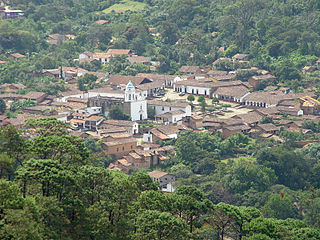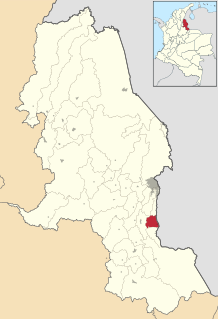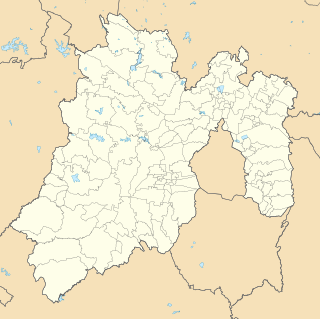
Cúcuta, officially San José de Cúcuta is a Colombian municipality, capital of the department of Norte de Santander and nucleus of the Metropolitan Area of Cúcuta. The city is located in the homonymous valley, at the foot of the Eastern Ranges of the Colombian Andes, on the border with Venezuela. It comprises an area of approximately 1119 km², with an urban area of 64 km² and a rural area of 1055 km².
Tlaltizapán de Zapata is a city in the Mexican state of Morelos. It stands at 18°4′N99°07′W.
Xochitepec is a municipio (municipality) of the state of Morelos, in central Mexico. Xochitepec is also the name of its principal township and seat of the municipal government. It is located approximately 13 km (8.1 mi) to the south of the capital of Morelos, Cuernavaca, on the southern outskirts of that city's greater metropolitan area.

Getafe is a city in the Community of Madrid, Spain. As of 2018, it has a population of 180,747, the region's sixth most populated municipality.

The Camino Real de Tierra Adentro was an historic 2,560-kilometre-long (1,590 mi) trade route between Mexico City and San Juan Pueblo, New Mexico, USA, from 1598 to 1882. It was the northernmost of the four major "royal roads" that linked Mexico City to its major tributaries during and after the Spanish colonial era.

Almoloya de Juárez is a town in the State of Mexico and the seat of the municipality of Almoloya de Juárez. The name Almoloya comes from the Nahuatl, that is properly Almoloyan, composed of: atl, "water"; molo "impersonal voice of moloni, to flow the source" and yan, "place"; that it means "place where flows the water source".

San Sebastián del Oeste is a town and municipality, located on the western part of Jalisco state, Mexico, between 20°39’45’’ - 21°02’30’’ N and 104°35’00’’ - 104°51’00’’ W, at a height of 1,480 metres (4,856 ft).

The department of Norte de Santander in northwestern Colombia, and its capital, Cúcuta, contains several rivers. The rivers are mostly part of the Maracaibo Lake basin, with the southeastern section located in the Magdalena River basin. Important fluvial elements are the Zulia, Catatumbo and Pamplonita Rivers. The entity in charge of taking care of these hydrology of Norte de Santander is Corponor.

Aguachica, is a small city and municipality in the southern region of the Cesar Department, Colombia. It was officially founded on August 16, 1748, by José Lázaro de Rivera.

Villa del Rosario is a Colombian municipality and town located in the eastern part of North Santander department. It is part of the Metropolitan Area of Cúcuta. The municipality is bordered to the north by Venezuela and the municipality of Cúcuta, to the south by the municipalities of Ragonvalia and Chinácota, to the east by Venezuela and to the west by the municipality of Los Patios.

Tibú is a municipality of Colombia located in the department of Norte de Santander, in the northeast of the country, on the border with Venezuela and on the banks of the Tibú River. It is the 160th most populated cities of Colombia is number, and is the 6th in the department after Cúcuta, Ocaña, Villa del Rosario, Los Patios and Pamplona. It has an airport, and is connected by national road with Cúcuta, Ocaña and El Tarra.

Ragonvalia is a Colombian municipality and town located in the department of North Santander.

Guadalupe is a town and municipality in the Santander Department in northeastern Colombia. It was founded in 1715 by the family Camacho Sabidos, in the lead of the Spanish Captain José Camacho Sabidos and management of Don Juan de Herrera and Tovar, according to church records of the year 1713.

Encarnación de Díaz is a town and municipality located in the far northeast of the state of Jalisco in north-central Mexico. It is located in a natural pass that connects the Los Altos region of Jalisco to points north, and from pre-Hispanic times until the 20th century, it was a major thoroughfare for north-south travel. The town began as a way station along a road built through this pass in the 17th century, formally becoming a town in 1760. It began to function as a municipality in the latter 19th century, but this status was not confirmed until the early 20th. Transport, along with numerous prosperous haciendas supported the economy of the area until the early 20th century, when travel patterns and the Mexican Revolution spurred its decline. In the 1920s, it was a centre of rebellion during the Cristero War, and the town contains Mexico's only museum exclusively dedicated to this episode in history. It also contains a museum dedicated to various naturally occurring mummies which have been found in the municipal cemetery.

Candeleda is a town and municipality located in the province of Ávila, in the autonomous community of Castile and León, Spain. According to the 2011 INE census, the municipality has a population of 5,213 inhabitants, making it the fifth largest municipality in the province after Ávila –the capital–, Arévalo, Arenas de San Pedro and Las Navas del Marqués. The town is located on the southern hillside of the Gredos mountains, 432 m above sea level, giving it a microclimate with a thermal regime of mild winters and hot summers and average summer temperatures of 26 °C.

North Santander is a department of Northeastern Colombia. It is in the north of the country, bordering Venezuela. Its capital is Cúcuta, one of the country's major cities.

Tepotzotlán is a city and a municipality in the Mexican state of Mexico. It is located 40 km (25 mi) northeast of Mexico City about a 45-minute drive along the Mexico City-Querétaro at marker number 41. In Aztec times, the area was the center of a dominion that negotiated to keep most of its independence in return with being allied with the Aztec Triple Alliance. Later, it would also be part of a "Republic of the Indians," allowing for some autonomy under Spanish rule as well. The town became a major educational center during the colonial period when the Jesuits established the College of San Francisco Javier. The college complex that grew from its beginnings in 1580 would remain an educational center until 1914. Today this complex houses the Museo del Virreinato, with one of the largest collections of art and other objects from this time period.

Huasca de Ocampo is a town and municipality of the state of Hidalgo in central Mexico. It is located 34 km from Pachuca and 16 km from Real del Monte in the Pachuca Mountains. While the town itself is just within the mountain range, much of the municipal land is located in a valley that opens up to the east of the town. While one of the first haciendas to be established in Mexico is located here, economic development started with mining haciendas built by Pedro Romero de Terreros in the 18th century. By the mid 20th century, none of these haciendas were in existence, having been broken up into communal farm lands and some even fully or partially under lakes created by dams. While agriculture remains important economically, the area has been promoted as a tourism destination, especially for weekend visitors from Mexico City, with attractions such as canyons, traditional houses, old hacienda facilities and waterfalls.
Píntag is an agrarian village located 27.5 kilometers southeast of Quito in Pichincha Province, Ecuador.




















